Project Management: Insurance Company Relocation Project
VerifiedAdded on 2023/04/11
|16
|2013
|337
AI Summary
This document provides a project charter for an insurance company relocation project, including an overview, purpose, scope and objectives, deliverables and milestones, project schedule, assumptions and constraints, project budget, stakeholder roles and responsibilities, and charter acceptance.
Contribute Materials
Your contribution can guide someone’s learning journey. Share your
documents today.

Running Head: PROJECT MANAGEMENT
Insurance Company Relocation Project
Name of the Student
Name of the University
Insurance Company Relocation Project
Name of the Student
Name of the University
Secure Best Marks with AI Grader
Need help grading? Try our AI Grader for instant feedback on your assignments.
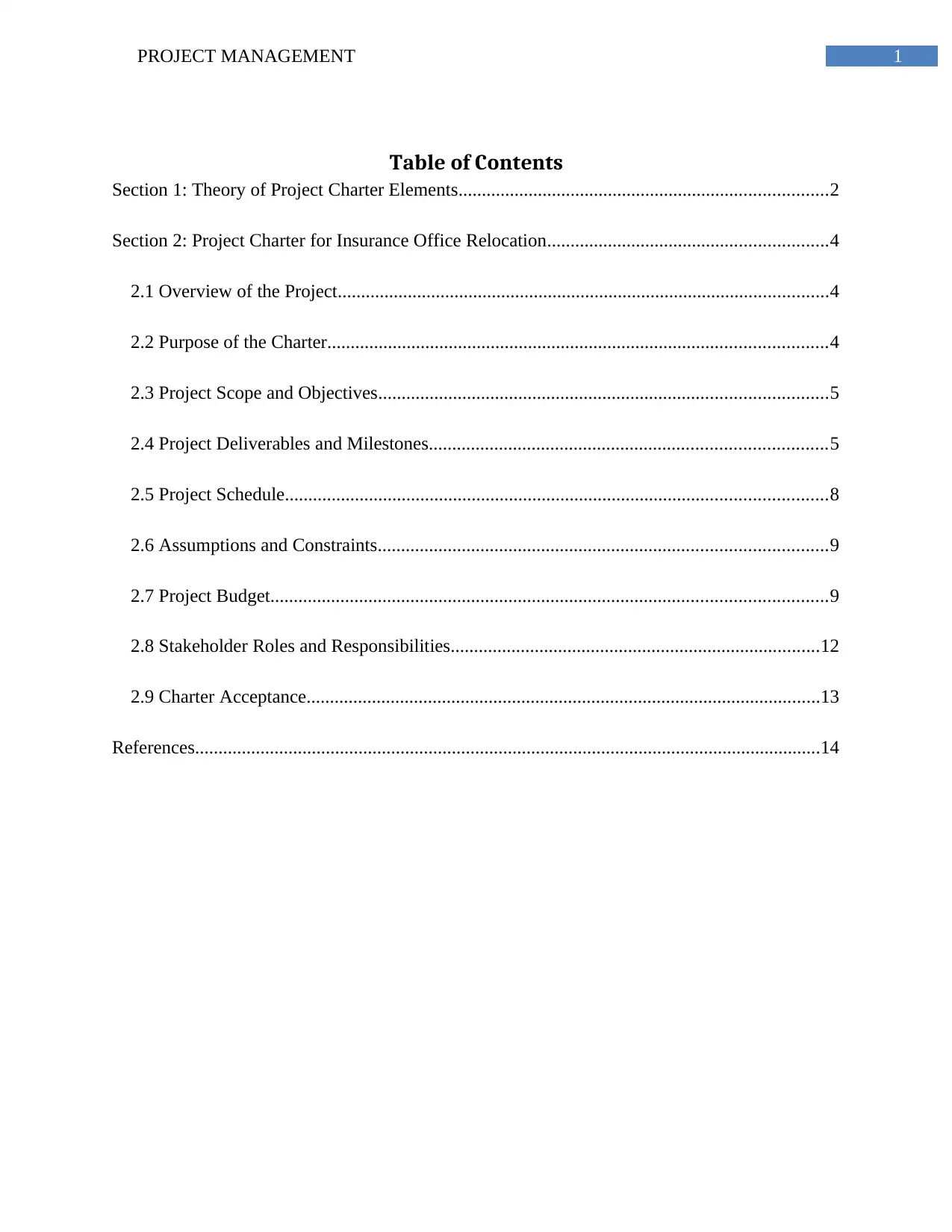
1PROJECT MANAGEMENT
Table of Contents
Section 1: Theory of Project Charter Elements...............................................................................2
Section 2: Project Charter for Insurance Office Relocation............................................................4
2.1 Overview of the Project.........................................................................................................4
2.2 Purpose of the Charter...........................................................................................................4
2.3 Project Scope and Objectives................................................................................................5
2.4 Project Deliverables and Milestones.....................................................................................5
2.5 Project Schedule....................................................................................................................8
2.6 Assumptions and Constraints................................................................................................9
2.7 Project Budget.......................................................................................................................9
2.8 Stakeholder Roles and Responsibilities...............................................................................12
2.9 Charter Acceptance..............................................................................................................13
References......................................................................................................................................14
Table of Contents
Section 1: Theory of Project Charter Elements...............................................................................2
Section 2: Project Charter for Insurance Office Relocation............................................................4
2.1 Overview of the Project.........................................................................................................4
2.2 Purpose of the Charter...........................................................................................................4
2.3 Project Scope and Objectives................................................................................................5
2.4 Project Deliverables and Milestones.....................................................................................5
2.5 Project Schedule....................................................................................................................8
2.6 Assumptions and Constraints................................................................................................9
2.7 Project Budget.......................................................................................................................9
2.8 Stakeholder Roles and Responsibilities...............................................................................12
2.9 Charter Acceptance..............................................................................................................13
References......................................................................................................................................14

2PROJECT MANAGEMENT
Section 1: Theory of Project Charter Elements
The main elements of project charter are listed as follows along with their detailed
explanation as found in literature.
Overview of the Project – This is the introductory section of a project charter that
provides an overall background information of the project to the reader (Kerzner and Kerzner
2017). The overview of the project includes the context of the project plan and why it is being
executed. The overview also includes the discussion of benefits that are expected from the
project.
Purpose of the Charter – In this section, the main discussion is based on the reason for
developing this charter. There are many projects that do not require project charter and the plans
are made differently. Project charter serves its own important purpose that helps the project
management to develop a fully fledged project plan (Heldman 2018). Even if the complete
project plan is not developed, the charter can act as a preliminary plan that can give the basic
idea of the overall project plan.
Project Scope and Objectives – Project scope is defined as the boundary that is set during
planning such that the project stays within a particular limit. Without the project scope, the
project will move out of control at one point causing huge losses to the parent organisation. In a
charter, the project scope is mainly defined using a six item checklist that includes objective, key
milestones, high level requirements, assumptions and exclusions, issues and risks and key
stakeholders (Kloppenborg, Anantatmula and Wells 2018). On the other hand, project objectives
define the main outcomes and requirements that are expected as the end product of the project. In
Section 1: Theory of Project Charter Elements
The main elements of project charter are listed as follows along with their detailed
explanation as found in literature.
Overview of the Project – This is the introductory section of a project charter that
provides an overall background information of the project to the reader (Kerzner and Kerzner
2017). The overview of the project includes the context of the project plan and why it is being
executed. The overview also includes the discussion of benefits that are expected from the
project.
Purpose of the Charter – In this section, the main discussion is based on the reason for
developing this charter. There are many projects that do not require project charter and the plans
are made differently. Project charter serves its own important purpose that helps the project
management to develop a fully fledged project plan (Heldman 2018). Even if the complete
project plan is not developed, the charter can act as a preliminary plan that can give the basic
idea of the overall project plan.
Project Scope and Objectives – Project scope is defined as the boundary that is set during
planning such that the project stays within a particular limit. Without the project scope, the
project will move out of control at one point causing huge losses to the parent organisation. In a
charter, the project scope is mainly defined using a six item checklist that includes objective, key
milestones, high level requirements, assumptions and exclusions, issues and risks and key
stakeholders (Kloppenborg, Anantatmula and Wells 2018). On the other hand, project objectives
define the main outcomes and requirements that are expected as the end product of the project. In
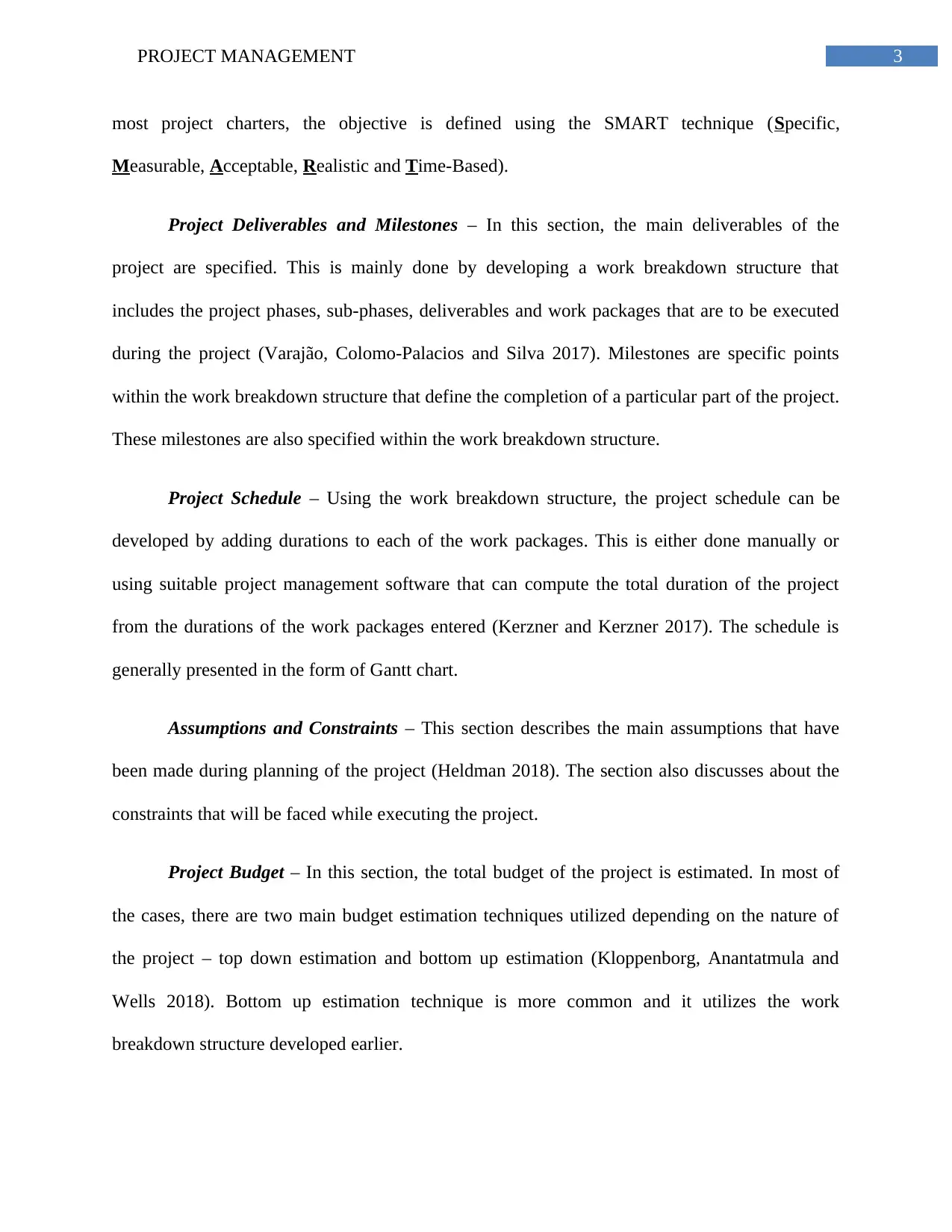
3PROJECT MANAGEMENT
most project charters, the objective is defined using the SMART technique (Specific,
Measurable, Acceptable, Realistic and Time-Based).
Project Deliverables and Milestones – In this section, the main deliverables of the
project are specified. This is mainly done by developing a work breakdown structure that
includes the project phases, sub-phases, deliverables and work packages that are to be executed
during the project (Varajão, Colomo-Palacios and Silva 2017). Milestones are specific points
within the work breakdown structure that define the completion of a particular part of the project.
These milestones are also specified within the work breakdown structure.
Project Schedule – Using the work breakdown structure, the project schedule can be
developed by adding durations to each of the work packages. This is either done manually or
using suitable project management software that can compute the total duration of the project
from the durations of the work packages entered (Kerzner and Kerzner 2017). The schedule is
generally presented in the form of Gantt chart.
Assumptions and Constraints – This section describes the main assumptions that have
been made during planning of the project (Heldman 2018). The section also discusses about the
constraints that will be faced while executing the project.
Project Budget – In this section, the total budget of the project is estimated. In most of
the cases, there are two main budget estimation techniques utilized depending on the nature of
the project – top down estimation and bottom up estimation (Kloppenborg, Anantatmula and
Wells 2018). Bottom up estimation technique is more common and it utilizes the work
breakdown structure developed earlier.
most project charters, the objective is defined using the SMART technique (Specific,
Measurable, Acceptable, Realistic and Time-Based).
Project Deliverables and Milestones – In this section, the main deliverables of the
project are specified. This is mainly done by developing a work breakdown structure that
includes the project phases, sub-phases, deliverables and work packages that are to be executed
during the project (Varajão, Colomo-Palacios and Silva 2017). Milestones are specific points
within the work breakdown structure that define the completion of a particular part of the project.
These milestones are also specified within the work breakdown structure.
Project Schedule – Using the work breakdown structure, the project schedule can be
developed by adding durations to each of the work packages. This is either done manually or
using suitable project management software that can compute the total duration of the project
from the durations of the work packages entered (Kerzner and Kerzner 2017). The schedule is
generally presented in the form of Gantt chart.
Assumptions and Constraints – This section describes the main assumptions that have
been made during planning of the project (Heldman 2018). The section also discusses about the
constraints that will be faced while executing the project.
Project Budget – In this section, the total budget of the project is estimated. In most of
the cases, there are two main budget estimation techniques utilized depending on the nature of
the project – top down estimation and bottom up estimation (Kloppenborg, Anantatmula and
Wells 2018). Bottom up estimation technique is more common and it utilizes the work
breakdown structure developed earlier.
Secure Best Marks with AI Grader
Need help grading? Try our AI Grader for instant feedback on your assignments.
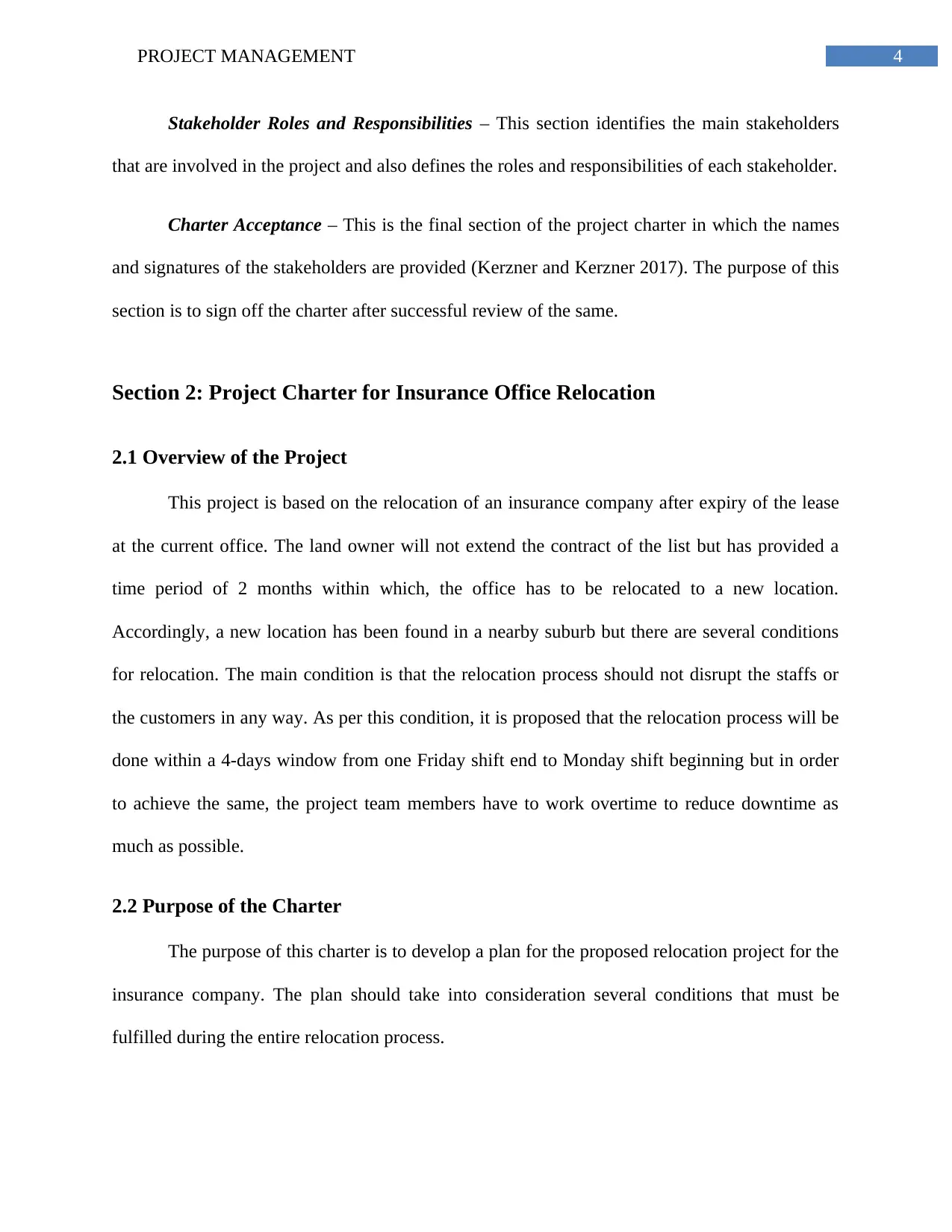
4PROJECT MANAGEMENT
Stakeholder Roles and Responsibilities – This section identifies the main stakeholders
that are involved in the project and also defines the roles and responsibilities of each stakeholder.
Charter Acceptance – This is the final section of the project charter in which the names
and signatures of the stakeholders are provided (Kerzner and Kerzner 2017). The purpose of this
section is to sign off the charter after successful review of the same.
Section 2: Project Charter for Insurance Office Relocation
2.1 Overview of the Project
This project is based on the relocation of an insurance company after expiry of the lease
at the current office. The land owner will not extend the contract of the list but has provided a
time period of 2 months within which, the office has to be relocated to a new location.
Accordingly, a new location has been found in a nearby suburb but there are several conditions
for relocation. The main condition is that the relocation process should not disrupt the staffs or
the customers in any way. As per this condition, it is proposed that the relocation process will be
done within a 4-days window from one Friday shift end to Monday shift beginning but in order
to achieve the same, the project team members have to work overtime to reduce downtime as
much as possible.
2.2 Purpose of the Charter
The purpose of this charter is to develop a plan for the proposed relocation project for the
insurance company. The plan should take into consideration several conditions that must be
fulfilled during the entire relocation process.
Stakeholder Roles and Responsibilities – This section identifies the main stakeholders
that are involved in the project and also defines the roles and responsibilities of each stakeholder.
Charter Acceptance – This is the final section of the project charter in which the names
and signatures of the stakeholders are provided (Kerzner and Kerzner 2017). The purpose of this
section is to sign off the charter after successful review of the same.
Section 2: Project Charter for Insurance Office Relocation
2.1 Overview of the Project
This project is based on the relocation of an insurance company after expiry of the lease
at the current office. The land owner will not extend the contract of the list but has provided a
time period of 2 months within which, the office has to be relocated to a new location.
Accordingly, a new location has been found in a nearby suburb but there are several conditions
for relocation. The main condition is that the relocation process should not disrupt the staffs or
the customers in any way. As per this condition, it is proposed that the relocation process will be
done within a 4-days window from one Friday shift end to Monday shift beginning but in order
to achieve the same, the project team members have to work overtime to reduce downtime as
much as possible.
2.2 Purpose of the Charter
The purpose of this charter is to develop a plan for the proposed relocation project for the
insurance company. The plan should take into consideration several conditions that must be
fulfilled during the entire relocation process.
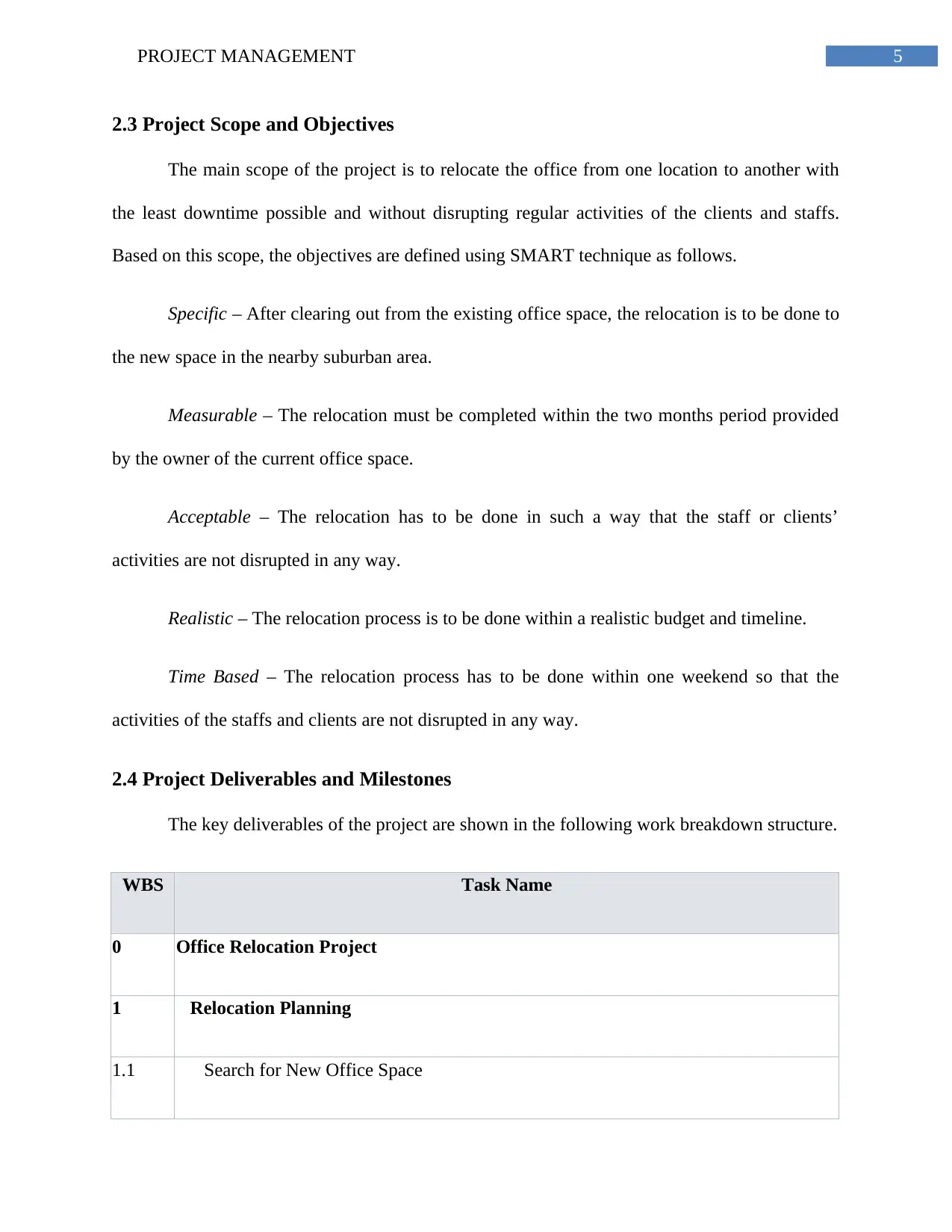
5PROJECT MANAGEMENT
2.3 Project Scope and Objectives
The main scope of the project is to relocate the office from one location to another with
the least downtime possible and without disrupting regular activities of the clients and staffs.
Based on this scope, the objectives are defined using SMART technique as follows.
Specific – After clearing out from the existing office space, the relocation is to be done to
the new space in the nearby suburban area.
Measurable – The relocation must be completed within the two months period provided
by the owner of the current office space.
Acceptable – The relocation has to be done in such a way that the staff or clients’
activities are not disrupted in any way.
Realistic – The relocation process is to be done within a realistic budget and timeline.
Time Based – The relocation process has to be done within one weekend so that the
activities of the staffs and clients are not disrupted in any way.
2.4 Project Deliverables and Milestones
The key deliverables of the project are shown in the following work breakdown structure.
WBS Task Name
0 Office Relocation Project
1 Relocation Planning
1.1 Search for New Office Space
2.3 Project Scope and Objectives
The main scope of the project is to relocate the office from one location to another with
the least downtime possible and without disrupting regular activities of the clients and staffs.
Based on this scope, the objectives are defined using SMART technique as follows.
Specific – After clearing out from the existing office space, the relocation is to be done to
the new space in the nearby suburban area.
Measurable – The relocation must be completed within the two months period provided
by the owner of the current office space.
Acceptable – The relocation has to be done in such a way that the staff or clients’
activities are not disrupted in any way.
Realistic – The relocation process is to be done within a realistic budget and timeline.
Time Based – The relocation process has to be done within one weekend so that the
activities of the staffs and clients are not disrupted in any way.
2.4 Project Deliverables and Milestones
The key deliverables of the project are shown in the following work breakdown structure.
WBS Task Name
0 Office Relocation Project
1 Relocation Planning
1.1 Search for New Office Space

6PROJECT MANAGEMENT
1.2 Selection of Office Space
1.3 Discussion Regarding New Office Location
1.4 Receive Approval from CEO Regarding Relocation
1.5 Milestone 1: Finalization of Relocation
2 Preparation for Relocation
2.1 Hire Subject Matter Experts
2.2 Develop Project Plan
2.3 Determine Schedule
2.4 Determine Final Budget
2.5 Consider the Constraints of the Project
2.6 Finalize Contract with New Office Space Owner
2.7 Milestone 2: Completion of Preparations
3 Relocation Process
3.1 Pack All Office Equipments
3.2 Clean Up the Entire Office
3.3 Transport the Equipments to New Location
1.2 Selection of Office Space
1.3 Discussion Regarding New Office Location
1.4 Receive Approval from CEO Regarding Relocation
1.5 Milestone 1: Finalization of Relocation
2 Preparation for Relocation
2.1 Hire Subject Matter Experts
2.2 Develop Project Plan
2.3 Determine Schedule
2.4 Determine Final Budget
2.5 Consider the Constraints of the Project
2.6 Finalize Contract with New Office Space Owner
2.7 Milestone 2: Completion of Preparations
3 Relocation Process
3.1 Pack All Office Equipments
3.2 Clean Up the Entire Office
3.3 Transport the Equipments to New Location
Paraphrase This Document
Need a fresh take? Get an instant paraphrase of this document with our AI Paraphraser
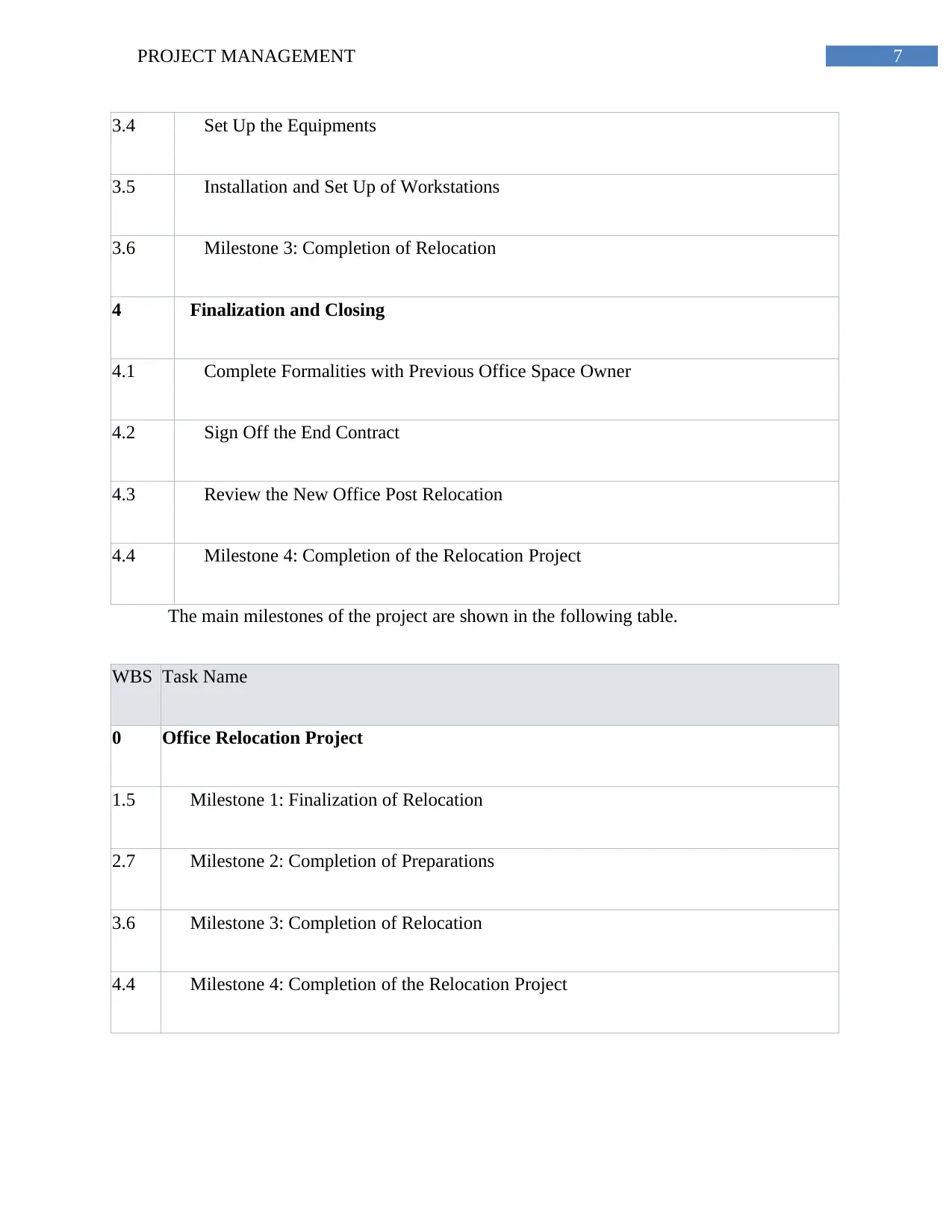
7PROJECT MANAGEMENT
3.4 Set Up the Equipments
3.5 Installation and Set Up of Workstations
3.6 Milestone 3: Completion of Relocation
4 Finalization and Closing
4.1 Complete Formalities with Previous Office Space Owner
4.2 Sign Off the End Contract
4.3 Review the New Office Post Relocation
4.4 Milestone 4: Completion of the Relocation Project
The main milestones of the project are shown in the following table.
WBS Task Name
0 Office Relocation Project
1.5 Milestone 1: Finalization of Relocation
2.7 Milestone 2: Completion of Preparations
3.6 Milestone 3: Completion of Relocation
4.4 Milestone 4: Completion of the Relocation Project
3.4 Set Up the Equipments
3.5 Installation and Set Up of Workstations
3.6 Milestone 3: Completion of Relocation
4 Finalization and Closing
4.1 Complete Formalities with Previous Office Space Owner
4.2 Sign Off the End Contract
4.3 Review the New Office Post Relocation
4.4 Milestone 4: Completion of the Relocation Project
The main milestones of the project are shown in the following table.
WBS Task Name
0 Office Relocation Project
1.5 Milestone 1: Finalization of Relocation
2.7 Milestone 2: Completion of Preparations
3.6 Milestone 3: Completion of Relocation
4.4 Milestone 4: Completion of the Relocation Project
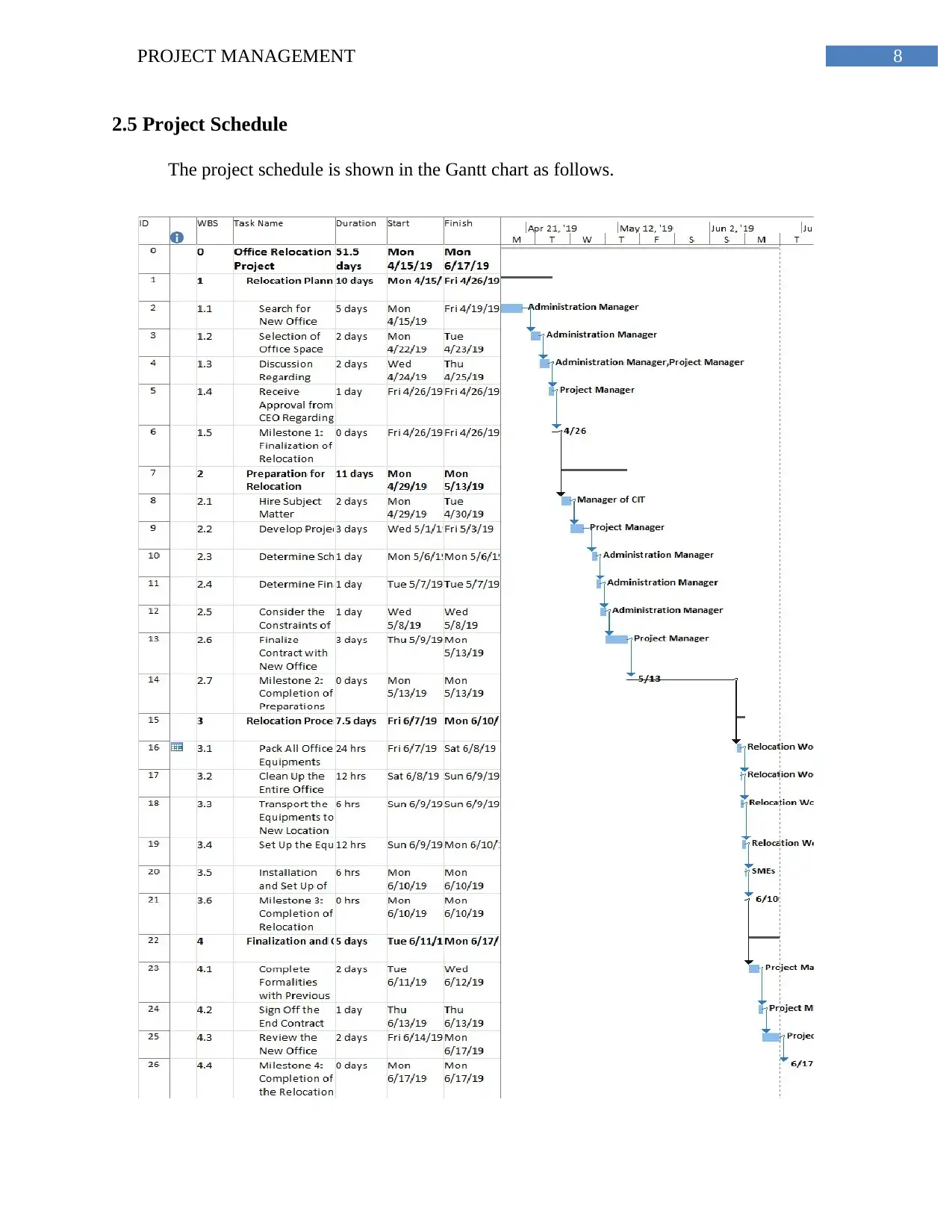
8PROJECT MANAGEMENT
2.5 Project Schedule
The project schedule is shown in the Gantt chart as follows.
2.5 Project Schedule
The project schedule is shown in the Gantt chart as follows.
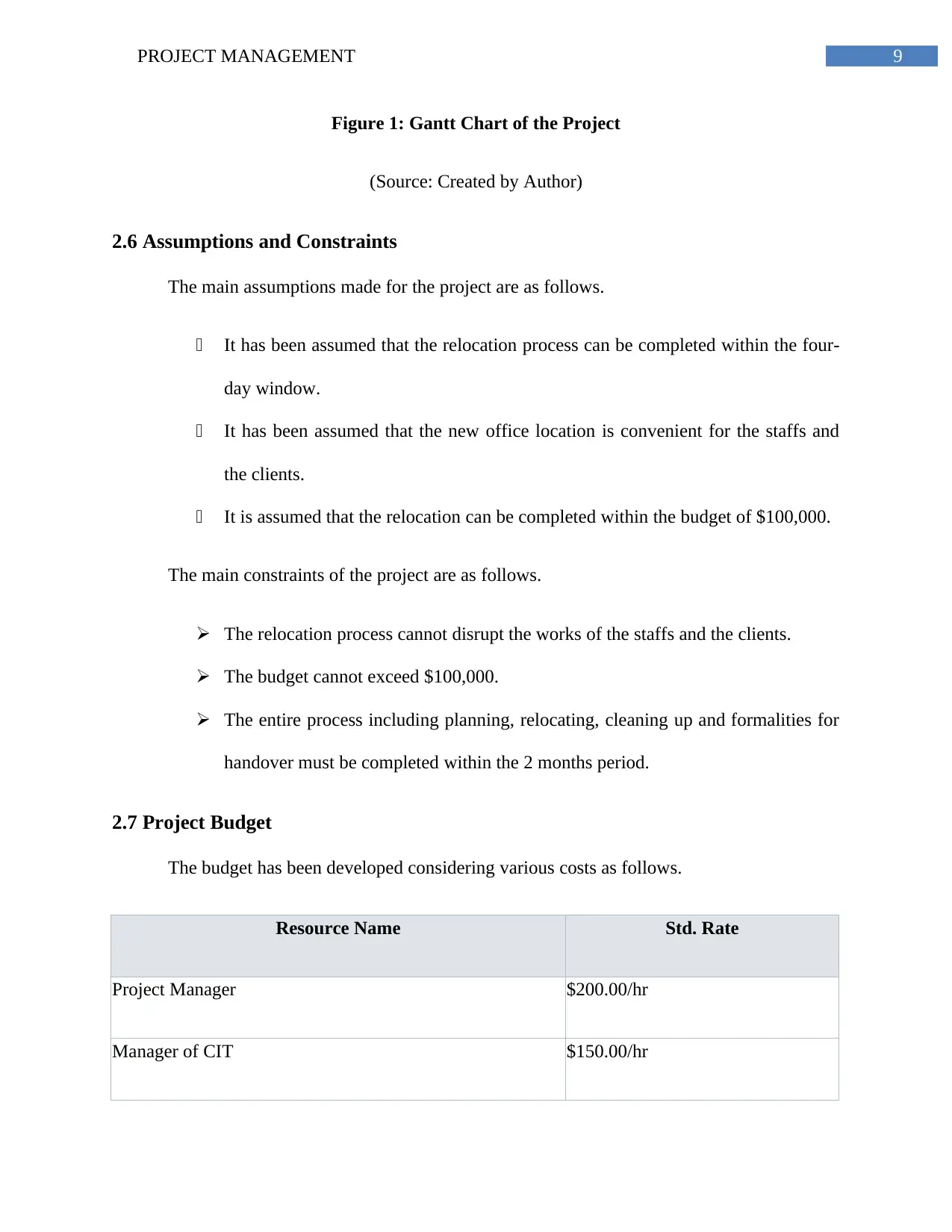
9PROJECT MANAGEMENT
Figure 1: Gantt Chart of the Project
(Source: Created by Author)
2.6 Assumptions and Constraints
The main assumptions made for the project are as follows.
It has been assumed that the relocation process can be completed within the four-
day window.
It has been assumed that the new office location is convenient for the staffs and
the clients.
It is assumed that the relocation can be completed within the budget of $100,000.
The main constraints of the project are as follows.
The relocation process cannot disrupt the works of the staffs and the clients.
The budget cannot exceed $100,000.
The entire process including planning, relocating, cleaning up and formalities for
handover must be completed within the 2 months period.
2.7 Project Budget
The budget has been developed considering various costs as follows.
Resource Name Std. Rate
Project Manager $200.00/hr
Manager of CIT $150.00/hr
Figure 1: Gantt Chart of the Project
(Source: Created by Author)
2.6 Assumptions and Constraints
The main assumptions made for the project are as follows.
It has been assumed that the relocation process can be completed within the four-
day window.
It has been assumed that the new office location is convenient for the staffs and
the clients.
It is assumed that the relocation can be completed within the budget of $100,000.
The main constraints of the project are as follows.
The relocation process cannot disrupt the works of the staffs and the clients.
The budget cannot exceed $100,000.
The entire process including planning, relocating, cleaning up and formalities for
handover must be completed within the 2 months period.
2.7 Project Budget
The budget has been developed considering various costs as follows.
Resource Name Std. Rate
Project Manager $200.00/hr
Manager of CIT $150.00/hr
Secure Best Marks with AI Grader
Need help grading? Try our AI Grader for instant feedback on your assignments.
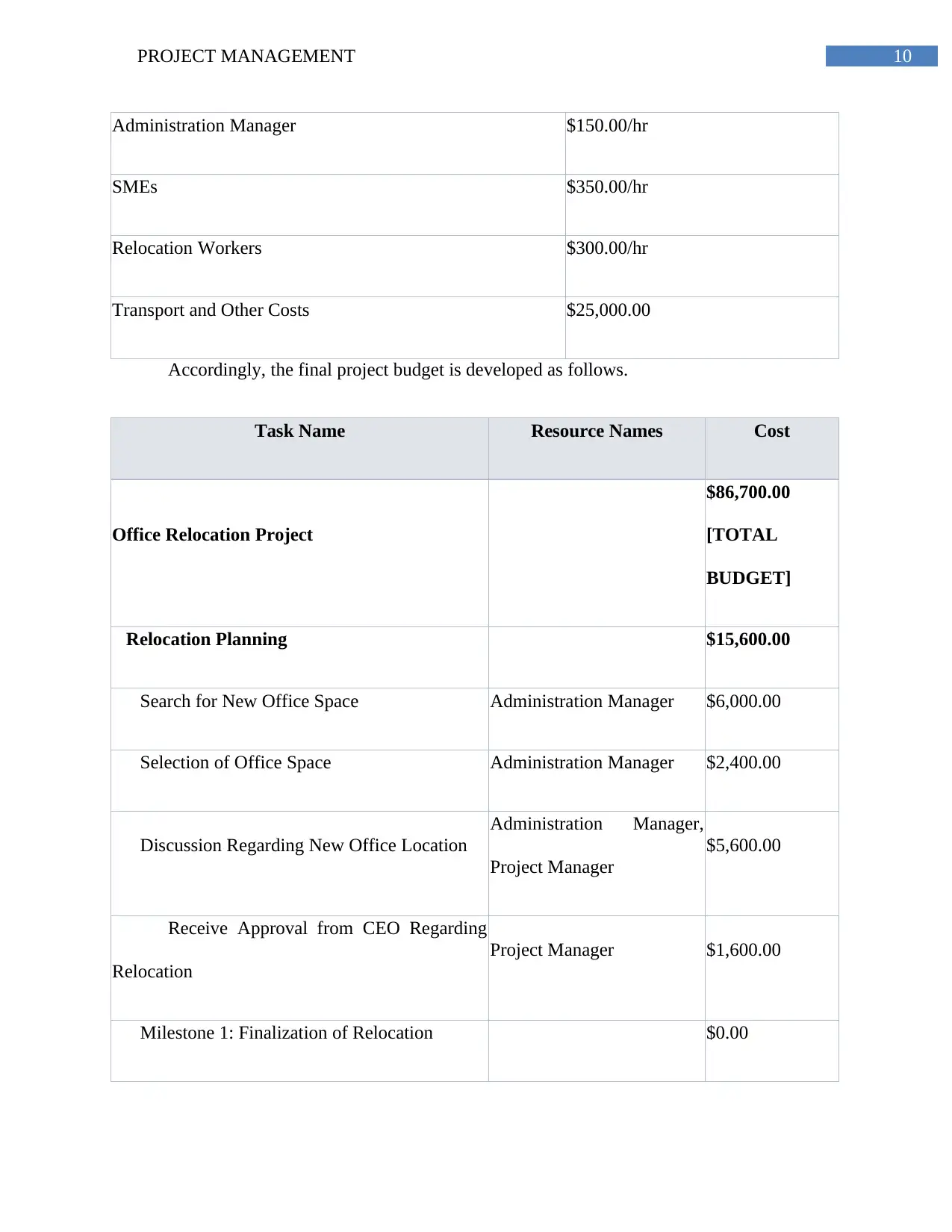
10PROJECT MANAGEMENT
Administration Manager $150.00/hr
SMEs $350.00/hr
Relocation Workers $300.00/hr
Transport and Other Costs $25,000.00
Accordingly, the final project budget is developed as follows.
Task Name Resource Names Cost
Office Relocation Project
$86,700.00
[TOTAL
BUDGET]
Relocation Planning $15,600.00
Search for New Office Space Administration Manager $6,000.00
Selection of Office Space Administration Manager $2,400.00
Discussion Regarding New Office Location
Administration Manager,
Project Manager
$5,600.00
Receive Approval from CEO Regarding
Relocation
Project Manager $1,600.00
Milestone 1: Finalization of Relocation $0.00
Administration Manager $150.00/hr
SMEs $350.00/hr
Relocation Workers $300.00/hr
Transport and Other Costs $25,000.00
Accordingly, the final project budget is developed as follows.
Task Name Resource Names Cost
Office Relocation Project
$86,700.00
[TOTAL
BUDGET]
Relocation Planning $15,600.00
Search for New Office Space Administration Manager $6,000.00
Selection of Office Space Administration Manager $2,400.00
Discussion Regarding New Office Location
Administration Manager,
Project Manager
$5,600.00
Receive Approval from CEO Regarding
Relocation
Project Manager $1,600.00
Milestone 1: Finalization of Relocation $0.00
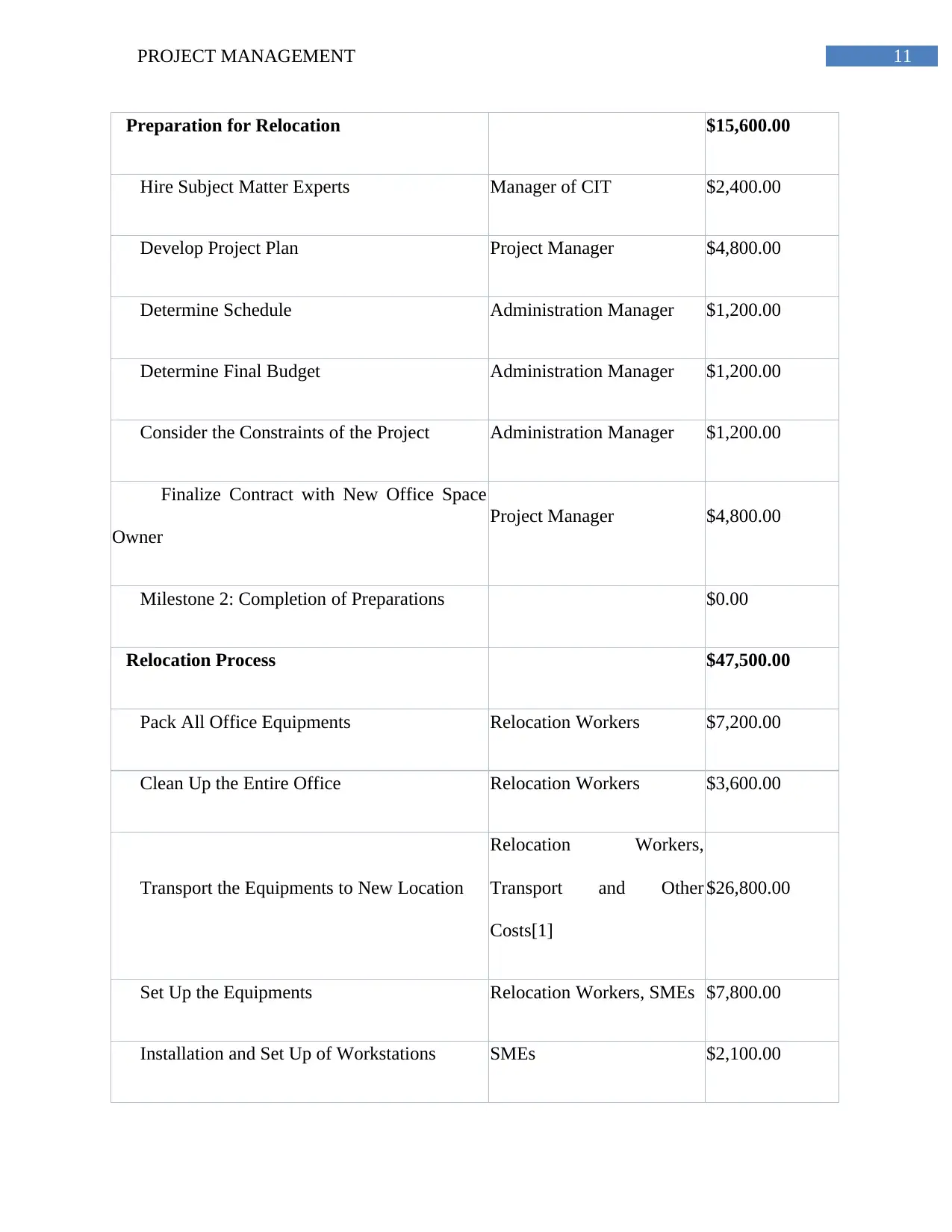
11PROJECT MANAGEMENT
Preparation for Relocation $15,600.00
Hire Subject Matter Experts Manager of CIT $2,400.00
Develop Project Plan Project Manager $4,800.00
Determine Schedule Administration Manager $1,200.00
Determine Final Budget Administration Manager $1,200.00
Consider the Constraints of the Project Administration Manager $1,200.00
Finalize Contract with New Office Space
Owner
Project Manager $4,800.00
Milestone 2: Completion of Preparations $0.00
Relocation Process $47,500.00
Pack All Office Equipments Relocation Workers $7,200.00
Clean Up the Entire Office Relocation Workers $3,600.00
Transport the Equipments to New Location
Relocation Workers,
Transport and Other
Costs[1]
$26,800.00
Set Up the Equipments Relocation Workers, SMEs $7,800.00
Installation and Set Up of Workstations SMEs $2,100.00
Preparation for Relocation $15,600.00
Hire Subject Matter Experts Manager of CIT $2,400.00
Develop Project Plan Project Manager $4,800.00
Determine Schedule Administration Manager $1,200.00
Determine Final Budget Administration Manager $1,200.00
Consider the Constraints of the Project Administration Manager $1,200.00
Finalize Contract with New Office Space
Owner
Project Manager $4,800.00
Milestone 2: Completion of Preparations $0.00
Relocation Process $47,500.00
Pack All Office Equipments Relocation Workers $7,200.00
Clean Up the Entire Office Relocation Workers $3,600.00
Transport the Equipments to New Location
Relocation Workers,
Transport and Other
Costs[1]
$26,800.00
Set Up the Equipments Relocation Workers, SMEs $7,800.00
Installation and Set Up of Workstations SMEs $2,100.00

12PROJECT MANAGEMENT
Milestone 3: Completion of Relocation $0.00
Finalization and Closing $8,000.00
Complete Formalities with Previous Office
Space Owner
Project Manager $3,200.00
Sign Off the End Contract Project Manager $1,600.00
Review the New Office Post Relocation Project Manager $3,200.00
Milestone 4: Completion of the Relocation
Project
$0.00
2.8 Stakeholder Roles and Responsibilities
The main stakeholders of the project and their responsibilities are defined as follows.
Stakeholder Name Designation Role and Responsibility
Mr. A CEO / Sponsor Fund the project
Mr. B Branch Manager / Project
Manager
Supervise, guide and control the
project
Mr. C Manager of Communications and
Information Technology (CIT)
Supervise relocation and
installation of computers and
telephones
Mr. D Administration Manager Assistance and reporting in the
project
Milestone 3: Completion of Relocation $0.00
Finalization and Closing $8,000.00
Complete Formalities with Previous Office
Space Owner
Project Manager $3,200.00
Sign Off the End Contract Project Manager $1,600.00
Review the New Office Post Relocation Project Manager $3,200.00
Milestone 4: Completion of the Relocation
Project
$0.00
2.8 Stakeholder Roles and Responsibilities
The main stakeholders of the project and their responsibilities are defined as follows.
Stakeholder Name Designation Role and Responsibility
Mr. A CEO / Sponsor Fund the project
Mr. B Branch Manager / Project
Manager
Supervise, guide and control the
project
Mr. C Manager of Communications and
Information Technology (CIT)
Supervise relocation and
installation of computers and
telephones
Mr. D Administration Manager Assistance and reporting in the
project
Paraphrase This Document
Need a fresh take? Get an instant paraphrase of this document with our AI Paraphraser

13PROJECT MANAGEMENT
2.9 Charter Acceptance
Name Signature
Mr. A . . . . . . . . . . . . . . . . . . .
Mr. B . . . . . . . . . . . . . . . . . . .
Mr. C . . . . . . . . . . . . . . . . . . .
Mr. D . . . . . . . . . . . . . . . . . . .
2.9 Charter Acceptance
Name Signature
Mr. A . . . . . . . . . . . . . . . . . . .
Mr. B . . . . . . . . . . . . . . . . . . .
Mr. C . . . . . . . . . . . . . . . . . . .
Mr. D . . . . . . . . . . . . . . . . . . .

14PROJECT MANAGEMENT
References
Badewi, A., 2016. The impact of project management (PM) and benefits management (BM)
practices on project success: Towards developing a project benefits governance
framework. International Journal of Project Management, 34(4), pp.761-778.
Brioso, X., 2015. Integrating ISO 21500 guidance on project management, lean construction and
PMBOK. Procedia Engineering, 123, pp.76-84.
Demirkesen, S. and Ozorhon, B., 2017. Impact of integration management on construction
project management performance. International Journal of Project Management, 35(8),
pp.1639-1654.
Elias, A.A., 2016. Stakeholder analysis for Lean Six Sigma project management. International
Journal of Lean Six Sigma, 7(4), pp.394-405.
Fleming, Q.W. and Koppelman, J.M., 2016, December. Earned value project management.
Project Management Institute.
Heldman, K., 2018. PMP: project management professional exam study guide. John Wiley &
Sons.
Kerzner, H. and Kerzner, H.R., 2017. Project management: a systems approach to planning,
scheduling, and controlling. John Wiley & Sons.
Kloppenborg, TJ, Anantatmula, V and Wells, KN, 2018, Contemporary Project Management,
4th edn, Cengage Learning, Boston, MA, USA.
Martin, J. and Haggerty, N., 2017. The Project Charter as a Sensemaking Device.
References
Badewi, A., 2016. The impact of project management (PM) and benefits management (BM)
practices on project success: Towards developing a project benefits governance
framework. International Journal of Project Management, 34(4), pp.761-778.
Brioso, X., 2015. Integrating ISO 21500 guidance on project management, lean construction and
PMBOK. Procedia Engineering, 123, pp.76-84.
Demirkesen, S. and Ozorhon, B., 2017. Impact of integration management on construction
project management performance. International Journal of Project Management, 35(8),
pp.1639-1654.
Elias, A.A., 2016. Stakeholder analysis for Lean Six Sigma project management. International
Journal of Lean Six Sigma, 7(4), pp.394-405.
Fleming, Q.W. and Koppelman, J.M., 2016, December. Earned value project management.
Project Management Institute.
Heldman, K., 2018. PMP: project management professional exam study guide. John Wiley &
Sons.
Kerzner, H. and Kerzner, H.R., 2017. Project management: a systems approach to planning,
scheduling, and controlling. John Wiley & Sons.
Kloppenborg, TJ, Anantatmula, V and Wells, KN, 2018, Contemporary Project Management,
4th edn, Cengage Learning, Boston, MA, USA.
Martin, J. and Haggerty, N., 2017. The Project Charter as a Sensemaking Device.
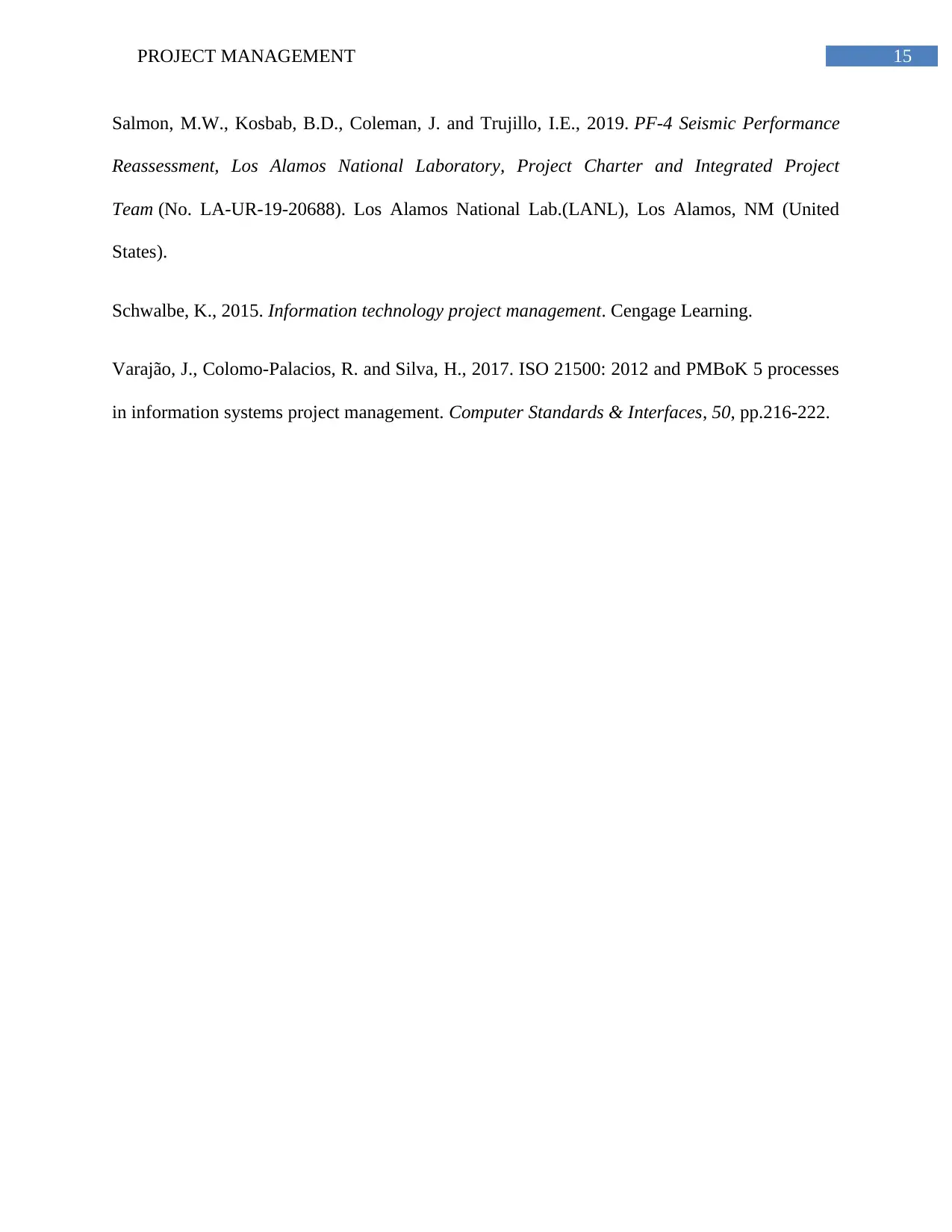
15PROJECT MANAGEMENT
Salmon, M.W., Kosbab, B.D., Coleman, J. and Trujillo, I.E., 2019. PF-4 Seismic Performance
Reassessment, Los Alamos National Laboratory, Project Charter and Integrated Project
Team (No. LA-UR-19-20688). Los Alamos National Lab.(LANL), Los Alamos, NM (United
States).
Schwalbe, K., 2015. Information technology project management. Cengage Learning.
Varajão, J., Colomo-Palacios, R. and Silva, H., 2017. ISO 21500: 2012 and PMBoK 5 processes
in information systems project management. Computer Standards & Interfaces, 50, pp.216-222.
Salmon, M.W., Kosbab, B.D., Coleman, J. and Trujillo, I.E., 2019. PF-4 Seismic Performance
Reassessment, Los Alamos National Laboratory, Project Charter and Integrated Project
Team (No. LA-UR-19-20688). Los Alamos National Lab.(LANL), Los Alamos, NM (United
States).
Schwalbe, K., 2015. Information technology project management. Cengage Learning.
Varajão, J., Colomo-Palacios, R. and Silva, H., 2017. ISO 21500: 2012 and PMBoK 5 processes
in information systems project management. Computer Standards & Interfaces, 50, pp.216-222.
1 out of 16
Related Documents
Your All-in-One AI-Powered Toolkit for Academic Success.
+13062052269
info@desklib.com
Available 24*7 on WhatsApp / Email
![[object Object]](/_next/static/media/star-bottom.7253800d.svg)
Unlock your academic potential
© 2024 | Zucol Services PVT LTD | All rights reserved.




